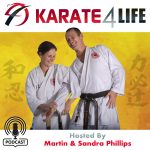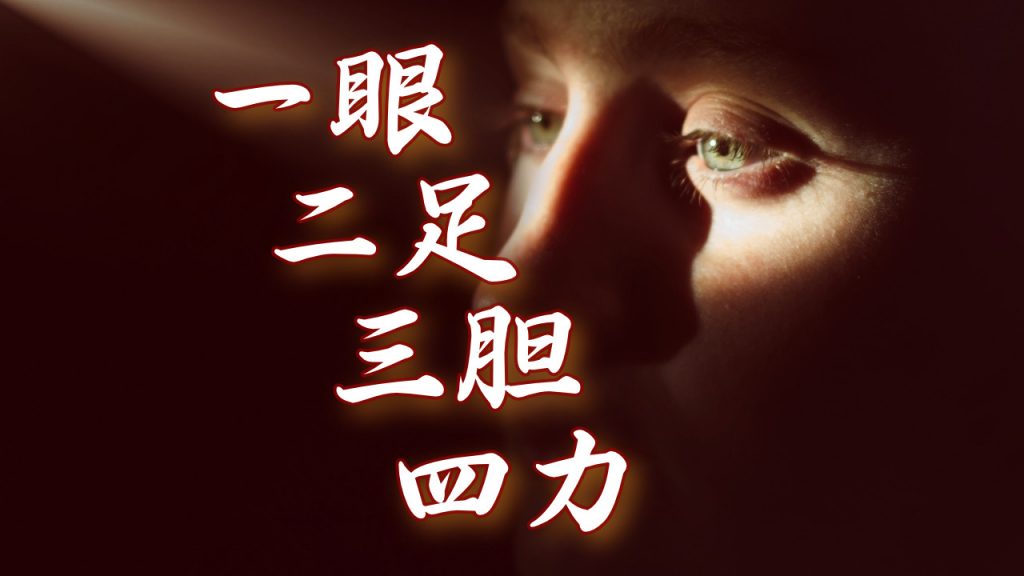
We’re very excited to be introducing an incredibly deep topic in this episode, but to be honest we feel like we’re only just scratching the surface.
It’s a bit of a technical topic, but it’s also a great metaphor for life.
In the dojo, we always ask the question, “What is it that I need to focus on the most that will have the biggest impact on what I’m trying to do?” In going as deep as you can on these concepts in this podcast you’ll always find a good answer to this question.
Hopefully it is more than enough to get you curious and keen to learn more. This episode is just a start, in upcoming episodes we will go deeper and explore each of the elements of this concept in greater detail.
—- Transcript —-
Sandra: Hey everyone, this is Martin & Sandra Phillips and welcome back to the Karate 4 Life Podcast.
Sandra: Today we want give you an introduction to the basics of karate and life.
Martin: Otherwise know as ichi gan, ni soku, san tan, shi riki.
We’ve noticed that everyone faces challenges in life, some big some small. But not everyone has a way to navigate these problems.
Sandra: It’s not always easy, but we’ve found that we always keep coming back to what we’ve learned from our years in the dojo.
Martin: And that’s what this podcast is about…
Sandra: Helping us all find the solutions to life’s problems…
Martin: Or even better yet, to remove the problems before they arise.
Sandra: This is Martin & Sandra Phillips and welcome to the Karate 4 Life Podcast.
Sandra: Wow, Martin I can’t believe we’re actually doing this one today. To be honest with you, when you first mentioned this, I thought, “You can’t be serious.” This is just–
Martin: It’s a bit of a deep topic this one, isn’t it?
Sandra: It’s so deep. It’s insanely deep. I don’t know how to explain it. It’s going to be a tough few episodes for us coming up, I think, because we’re only going to be scratching on the surface, if that.
Martin: Yes, this is a bit like that. This really is the foundation for everything that we do in the dojo. We look at this concept, ichi gan, ni soku, san tan, shi riki, and it is the basis of all basics. It’s the basis of everything that we do, not just in the dojo, but it’s a fantastic metaphor for life as well, as we take these lessons outside of the dojo as well.
Sandra: Yes. Even, I guess, right now, you could say, “A long story made short,” just really appreciate these concepts and really apply them and go deep as you possibly can.
Martin: We probably should explain what they are, shouldn’t we?
Sandra: We really should do that, yes. Okay. In the intro, we mentioned ichi gan, ni soku, san tan, and shi riki. I’m going to hand it over to you, because you’re our Japanese kanji expert. If you could please do a little bit of a quick meaning of these four.
Martin: Yes. Ichi gan, this first, is the eyes.
Sandra: Ichi means number one, right?
Martin: Number one. Ichi gan, yes. First, the eyes. Ni soku, the second, is legs or the stance.
Sandra: Ni is number two and Soku is legs.
Martin: San tan– I’m going to pause here for a moment, because this one’s often mistranslated and, to be honest, there’s not really a great English version of this. San tan is often translated as tanden– not really a translation, but just a Japanese word used. Tanden refers to the energy center in your body located in your lower abdomen. San tan is literally liver.
Sandra: Yes?
Martin: The liver. It kind of sounds a bit strange, but we’ll get to that later.
Sandra: We’ll get to that.
Martin: Shi riki, this fourth, is power. When you add these first three together, ichi gan, ni soku, san tan, shi riki– because shi equals riki, that’s the power.
Sandra: Like a birthday cake. There’s your ingredients; 1 + 2 + 3 = your cake that you just baked in the oven.
Martin: That’s the one. Yes. Good way to describe it.
Sandra: If you think of it like that, we’re going to be all good to go. All right. Let’s go just a little bit deep on this one. You’ve been to Japan many, many, many centuries ago.
[laughter]
Martin: Many times over the years, let’s say.
Sandra: I’m just playing. I’m just funny. I’m being a bit cheeky, sorry.
Martin: You do that, don’t you?
Sandra: I do. I do play along. Okay. You did do some wonderful work with the help of many people to help to do some translating. Do you want to share a bit of that, what your translation was?
Martin: This was back when I spent nearly a year living in Japan and training full-time back in 97-98, over 20 years ago now. I was very fortunate to have the opportunity to do some translation work on Soke’s Kyohon. Soke is my teacher. He’s the head of Chito-Ryu worldwide. His teaching manual, there was only a Japanese version of that, and I had the opportunity to translate, with the help of a lot of people– I might actually hand over to you to read just a brief excerpt about the ichi gan, ni soku, san tan, shi riki.
Sandra: Yes, sure thing. Okay. Gan, which is the eyes, number one: “It is said that the spirit of a person is shown most through the eyes. In budo, gan represents the power of insight into the movements of the opponent’s body, spirit, etc.” Then, we have soku: “The legs are the basis of all movement and posture. Always take care to unconsciously have correct and smooth-stepping motion, stance, and way of evasion.” Then we have tan, the one that you love to talk about so much, refers to the liver.
Martin: I’m going to butt in just really quickly just to–
Sandra: I knew you would.
Martin: Yes, you knew I would. Just a little bit of an aside. Although it refers to liver, I like to look at this one as referring to the gut, or the grit or determination. It also does tie in with the tanden, this all-encompassing thing, but the tanden alone is probably a little bit shallow.
Sandra: Yes. In some of my research, I’ve also learned that they refer to the tan in terms of bravery and determination.
Martin: It’s that emotional element or the spirit– You’ve probably heard of the saying, “It’s not the size of the dog in the fight, but the size of the fight in the dog.” This is kind of like that. It’s that extra element that you bring in outside of the physical technique.
Sandra: I love it. We’ll come back to that in the future, I’m sure. Then, we have–
Martin: Sorry, I’d better let you keep reading. I’m cutting in you there.
Sandra: Yes, thank you. Should I start again or we’ll just go back to where I was up to?
Martin: Back to where you’re up to.
Sandra: Okay. “Tan power is the foundation for cultivating Ki power, will power, perseverance, and endurance. By cultivating Tan power, spirit sickness, known as Shikai, and other such weaknesses are gone. Correct judgment ability results and bold attacks are possible.” It’s so cool, isn’t it?
Martin: That is really cool.
Sandra: Dig deep on that one everyone. Then, shi riki is technique. “Through diligent training of Kata and Kumite, technique will develop naturally.”
Martin: The interesting one on this– I’m just going to cut in on that one as well. Shi riki, although it says technique, the kanji character for riki is actually power. The way you do technique also adds to the power.
Sandra: Love it. All right. I know you want to do a little bit deeper, but we’re running out of time, really, for today. Do you want to just quickly look at, maybe, a surface-level idea of your thoughts on how this works in life– just really briefly?
Martin: Just a really brief one. A few months ago, we had a little bit of a brainstorming session. We might share this with everybody. We were looking at how do we apply this ichi gan, ni soku, san tan, shi riki to a business plan, and that was a really, really interesting process. It allowed us to really quickly give a snapshot of where we’re at and where we’re going.
Looking at the eyes, this is how you interpret what’s going on around you and looking forward and how you take in the world, how you interact with people.
Ni soku, that’s your grounding. What are the foundations that you have in your life, in your business, in whatever you’re doing.
San tan that’s the grit and determination, “Okay, let’s just do this. Let’s fight for this.”
Shi riki, that’s all the technical stuff. That’s all the step-by-step processes, in a business context, that allows us to move forward and correct some powerful movement forwards.
Sandra: It’s a very exciting topic, isn’t it?
Martin: It really is. It really is.
Sandra: It really gets you excited. It’s very hard to get you excited. Yes, I’m really excited to see where this one goes these next few episodes, and if we can help other people to, I guess, be inspired to learn more about ichi gan, ni soku, san tan and shi riki, because it’s such a powerful way to not only enhance the training in the dojo, but also to put more life into their own lives as well, and their family.
Martin: Yes. It’s a really exciting topic. I can’t wait to get a little bit deeper into each of those different elements.
Sandra: Okay. Just so everybody knows, we’ll be looking at one episode per idea here. Ichi gan will have its own episode, do you think? Or do you think we’ll just do a couple of —
Martin: I think we’ll try and give them one each, because, as you said, this is something you really can spend a lifetime studying, so we’ll aim to give an episode each, I reckon.
Sandra: Fantastic. Very excited.
Martin: Thanks for listening to today’s episode of the Karate 4 Life Podcast.
Sandra: If you found this episode useful, please comment on our website karate4life.com
Martin: Share it with your friends via social media and don’t forget to tag us #karate4lifepodcast.
And if you’ve got a topic that you’d like us to cover in future episodes or questions about karate or life…
Sandra: Please send us a message, we’d be more than happy to share our thoughts.
Martin: Thanks again for joining us and stay tuned for the next episode which will look deeper at the first element of ichi gan, ni soku, san tan, shi riki – the eyes.


Amazing session, can’t wait to listen to the breakdown of each element!!
I found your talks very enlightening. Thank you for sharing your knowledge!